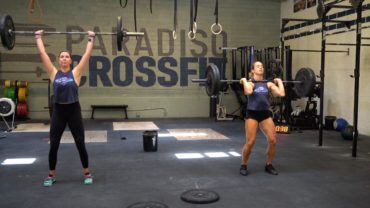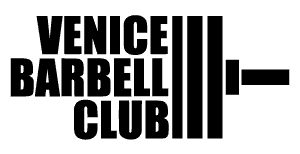Lean In
Weekly Programming Links: Group Class, Venice Barbell Club, Track Night, Gymnastics Club
Monday, May 12, 2014
Prehab
Banded Hip Extension
PVC Overhead Wall Squat
PVC Dislocates
Banded Overhead/Lat Distraction
Warmup
2x Rounds:
2 Burpees
4 Light Goblet Squats
6 Walking Lunges
8 Pushups
10 Light KB Swings
12 Pike Situps
Classic Strength
Back Squat 3×5- Rest 90 seconds
Press 3×5- Rest 90 seconds
Notes: You will perform your back squats first, then your presses second. This is the same work being performed as the Advanced strength, except without percentages. This is designed for the newer athlete that does not have a true 1 rep max, but we still want you to keep track of these numbers because you will be repeating them over the coming weeks. Perform 2 warmup sets and then add weight each set as needed.
Advanced Strength
Wendler Cycle 1, Week 4 (De-load)
Back Squat: 40% x 5, 50% x 5, 60% x 5
Press: 40% x 5, 50% x 5, 60% x 5
Notes: Percentages are based off 90% of true 1 RM. This is a deload week, weight should feel light and easy. Perform a few warm up sets before getting into your working sets. Keep rest intervals around 2 minutes or less. Click HERE for a full description of the Wendler 531 cycle.
Conditioning
3 Rounds for time:
30 Kettlebell Goblet Squats (24/16kg)
20 Chest to Bar Pull Ups
10 Hang Power Cleans (155/105#)
– 15 minute cap –
Notes: Regular pull ups and ring rows may be subbed. Pick a weight for the KB Front Squats that allows for close to unbroken rounds.
Cool Down
Couch Stretch, 1 min each
Pike Stretch, 1 min
Lat Stretch, 1 min each
This is dedicated to all the female athletes at PCF, and especially those with children. Happy belated Mother’s Day.
Abbye Eville Stockton was born on August 11, 1917, and moved to Santa Monica, California in 1924. She got the nickname “Pudgy” as a kid, and it stuck as an adult even though she weighed approximately 115 pounds at a height of 5’2″. She began lifting weights with her high school sweetheart, Les Stockton, and they married in 1941. The two of them were regulars at Muscle Beach, along with Jack LaLanne, Steve Reeves, and Joe Gold (founder of Gold’s gym). She became famous for numerous athletic feats, including supporting her husband, who weighed 180 pounds, in a handstand over her head (video below). In 1944 she began writing a monthly column for Strength & Health magazine, called “Barbelles”, where she promoted women’s strength training, and also helped organize the first sanction weightlifting contest for women in 1947. In that contest, she pressed 100 lb, Snatched 105 lb, and Clean & Jerked 135 lb.
She continually challenged the notion that lifting weights would make women manly or bulky. As she later told Sports Illustrated, ““In those days, lifting weights was thought to be unfeminine. The misinformed think if women strength-trained, they’d become masculine looking. We laughed knowing they were wrong.” She was also one of the first women to pose in a two piece bathing suit, made from a men’s bathing suit bottom and bra for the top, with the intent to better perform gymnastic movements. “You couldn’t buy a two piece, so my mother ripped a part a old brassiere to use as a pattern.” Her strength, charm, and beauty made her the poster girl for strength training, appearing in over 40 magazine covers by the end of the 1940s, and featured in multiple advertisements.
“Every woman in bodybuilding who puts on a swimsuit and steps on a posing dais; every woman straining beneath a clean and jerk, and every woman power lifter who fights through the pull of a heavy deadlift owes a debt of gratitude to Pudgy Stockton. She helped make these modern sports possible.” -Dr. Jan Todd, former “Strongest Woman in the World”
Pudgy Stockton and her husband Les
**********************
From the Essentials of Strength Training and Conditioning, 3rd edition (pages 151-152) by the National Strength and Conditioning Association (NSCA) on the Strength and Power Output difference between men and women:
When comparing training-induced changes in muscular strength between the sexes, it is important to distinguish between absolute and relative measures. In terms of absolute strength, women generally have about two-thirds the strength of men. The absolute lower body strength of women is generally closer to male values as compared to the absolute values for upper body strength. Sex related differences in body composition, anthropometric characteristics, and fat-free mass distribution (women tend to have less muscle above the waist) can partly explain these sex related differences, which are apparent in recreationally trained individuals as well as highly trained athletes.
When considered on a relative basis, sex-related differences in muscular strength are greatly reduced. Because the average man and woman differ considerably in body size, it is useful to compare sex differences in strength relative to body weight, fat-free mass, and muscle cross-sectional area. When expressed relative to body weight, the lower body strength of women is similar to that of men, while upper body strength of women is still somewhat less. If comparisons are made relative to fat-free mass, differences in strength between men and women tend to disappear…
When strength is expressed relative to muscle cross-sectional area, no significant difference exists between the sexes, which indicates that muscle quality (peak force per cross-sectional area) is not sex specific. Granted that the muscle fibers in men and women are also similar in fiber type distribution and histochemical characteristics, men tend to have a larger muscle fiber cross-sectional area than women…
Sex-related differences in power output are similar to those for muscular strength. Measurements comparing power outputs of competitive lifters revealed that during the entire snatch or clean pulling movements, women’s power output relative to total body weight was about 63% of men’s…
**********************
For Runner With M.S., No Pain While Racing, No Feeling at the Finish – The New York Times
**********************
Sheryl Sandberg, COO of Facebook and author of Lean In, a book dedicated to a more equitable society between men and women.
Stephen Colbert, and his comedy bit about Equal Pay Day (April 8)
















